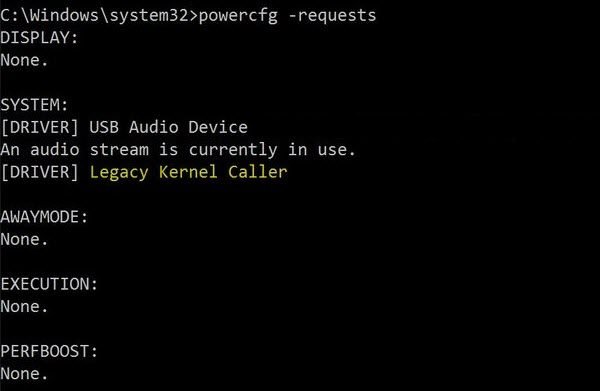Does the display of your computer turn on all of a sudden? No matter how often you put it to sleep, it always wakes up. Windows 11 or Windows 10 computer Sleep state is built such that only if it’s essential, it wakes up. The important thing can be either configured by you or when there is hardware interrupting the sleep. In this post, we are sharing how to troubleshoot the sleep issues because of Legacy Kernel Caller.
What is keeping my computer from going to sleep

An audio stream is currently in use
Instead of checking on power configuration, the best way to find out is to execute the command “powercfg -requests“. This command finds out requests from drivers, and applications that prevent the computer from going to sleep or turning off the display.
If you notice a mention of Legacy Kernel Caller in the result, this points to external hardware which is waking up your system. Part of the result will look as below:
SYSTEM
[DRIVER] USB AUDIO DEVICE
An audio stream is currently in use
[DRIVER] Legacy Kernel Caller.
Windows won’t go to Sleep – Legacy Kernel Caller
If your Windows 11/10 computer will not Sleep because of Legacy Kernel Caller driver, An audio stream is currently in use issue, here is how you can fix it.
1] Remove such external hardware
Remove such external hardware one by one from the computer. We have seen a lot of users reporting about “TV card”.
Once you remove it, run the command “powercfg -requests” again, and you should notice that “Legacy Kernel Caller” is no more in the list. Also, the computer will get into regular sleep mode once the hardware is removed. What happens is the driver gets hung and doesn’t release the power request despite being any longer in use.
2] Use Request Override
The powercfg command offers a request override option. It allows users to disable request from applications and services to wake the computer from sleep. Run this command on the Command Prompt (admin privileges) to disable it.
Powercfg -requestsoverride Driver "Legacy Kernel Caller" System
3] Check Streaming & Media Applications
If this is not the case, you must check if you are running a video or audio service in the background. You must have noticed that when you play a video, the computer never sleeps. If you had put the machine to sleep in between watching a video, the computer may be waking up because of that.
4] Check which devices can wake your system
Here is one last suggestion. If you don’t see any Legacy Kernel Caller in the result.
Execute the command powercfg -devicequery wake_armed.
It will list down all the devices that can wake your system. If there is anything other than keyboard, mouse, or touch, you need to check power configuration of that device.
Go to Device Manager, and disable the option in its Properties which says “Allow this device to wake the computer“.
5] Run the Power Troubleshooter
If Sleep Mode is not working, you could also run the Power Troubleshooter.
I have seen many suggestions to reset your power configuration plan, and even update the drivers – but that’s probably is the last thing you need to worry about.
We hope this post resolves your problem.
A Windows computer can face several other Sleep-related issues. Maybe some of these posts will help you someday.
- Windows goes to sleep automatically randomly
- Prevent Computer from waking up from Sleep
- Windows computer goes to Sleep too early
- Windows will not wake up from Sleep Mode
- Sleep Mode is not working in Windows
- Windows computer wakes from sleep automatically
- Wake up computer from Sleep, at a particular time.